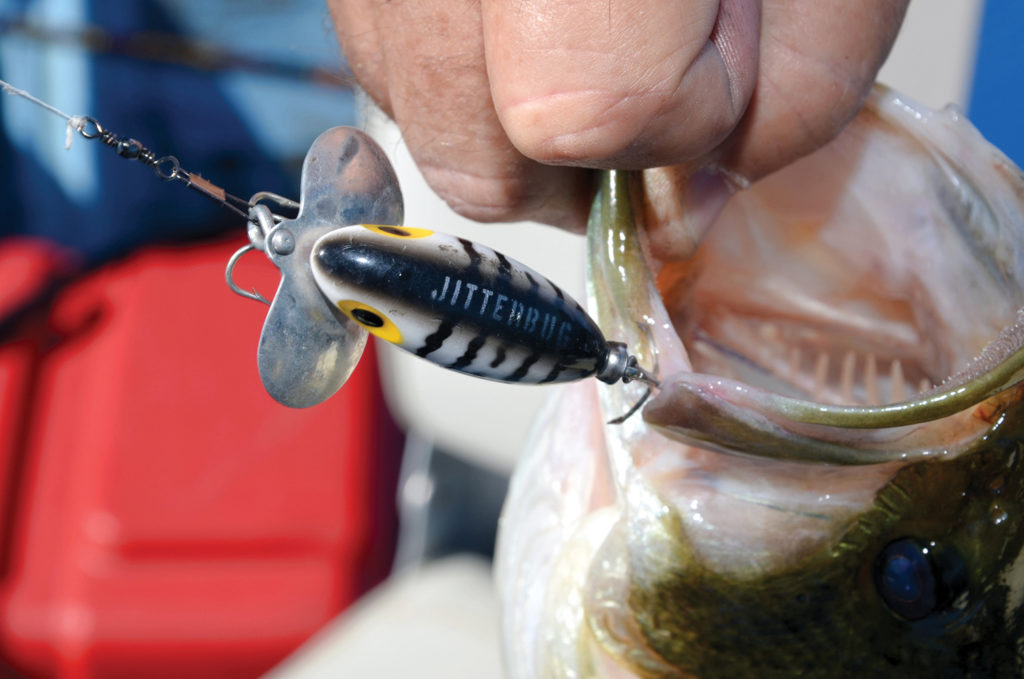Some lures still catch fish after more than a century
Look in any Alabama tackle box and people would likely see angling treasures, some dating back more than a century.
As early as the late 17th century, Scandinavian fishermen hammered metal kitchen spoons into fishing lures. About 150 years later, young J.T. Buel loved to fish. One day, he dropped his lunch spoon into the water. As it fluttered down, a big fish smacked it. Probably when his mother wasn’t looking, the youngster swiped another spoon from the kitchen and fashioned it into a fishing lure.
Buel made more spoon lures and sold them for years before he obtained a patent for the Buel Spoon in 1852, the first patent awarded for any fishing lure commercially sold in the United States. Spoons remain popular for both fresh and saltwater fishing.
A plumber by vocation and a dedicated fisherman by avocation, John J. Hildebrandt flattened and reshaped a dime in 1893. He drilled an offset hole through the coin and slipped his wife’s hairpin through the hole. He then fashioned an eye so he could tie a line to it and attached a hook.
When retrieved through the water, the dime spun enticingly around the pin, giving off flash and vibrations. In 1899, he founded the Hildebrandt Lure Company, which still exists today. In-line spinnerbaits like the venerable Hildebrandt Snagless Sally remain popular enticements for fishing around logs, fallen trees and other woody cover in places like the Mobile-Tensaw Delta.

The William J. Jamison Company started selling fishing lures in 1904, but W. J. “Smilin’ Bill” Jamison put a new spin on lures in 1915. He attached two wire arms to a jighead. Jamison added a rounded metal blade to each arm. The Jamison Shannon Twin Spin evolved into the “safety pin” spinnerbaits commonly used by bass fishermen today. Anglers can use downsized versions to entice crappie, bluegills and other panfish. Anglers fishing in salty waters also throw spinnerbaits for redfish and various other species.
Fred Arbogast began carving wooden lures in the 1920s. For one of his creations, he added a wide metal lip, a genuine oddity on any floating lure. Many people said the lure made such a crazy commotion that it reminded them of the gyrations of a popular dance of that time. The Jitterbug hit the market in 1939 and still entices vicious strikes.
In 1938, Arbogast obtained a patent for a fishing lure skirt. He attached it to an arrow-shaped metal head with wire weed guards. The Hawaiian Wiggler came with a very large propeller that could churn the surface if reeled fast enough. We call that lure type a buzzbait today.
Three years later, Arbogast put that same skirt on a wooden floater. In late 1941, Hawaii became very prominent in the news. The skirt reminded people of the grass skirts Hawaiian dancers wore. Arbogast called his creation a Hula Popper.
Another lure carver, Jack Smithwick, noticed the propellers on World War II aircraft. Inspired, Smithwick carved a wooden plug and added propellers to each end of his lure. He called his propbait a Devel’s Horse because many people wouldn’t buy anything with “devil” in the name back then. In 1960, the name changed to Devil’s Horse, still popular as one of the best topwater bass lures ever created.
Another innovative thinker, Lauri Rapala worked part-time as lumberjack and full-time as a commercial fisherman. In 1936, Rapala observed how predators slash into baitfish schools then single out the struggling wounded fish.
Rapala carved, filed and sanded cork chunks into various shapes until he came up with a design he liked that looked like a long, slender minnow. Rapala wrapped his creation in tinfoil and coated the body with melted photographic negatives to seal it because he could not obtain lacquer. Except for replacing cork with balsawood, the lure remains essentially unchanged.
By 1959, Normark began distributing the Rapala Original Floater in the United States, but sales really skyrocketed three years later. In August 1962, Life magazine broke all-time single-issue magazine sales records with a cover shot featuring screen legend Marilyn Monroe, who had recently died. However, another article in that same issue headlined “A Lure Fish Can’t Pass Up” spawned a new legend and catapulted sales for Rapala’s design.
These exact lures or similar designs remain on the market after decades or even centuries. Largely unchanged, except perhaps tweaked by modern technology and materials, these lures or variations of them still catch many species of fish.
John N. Felsher is a professional freelance writer who lives in Semmes, Ala. He also hosts an outdoors tips show for WAVH FM Talk 106.5 radio station in Mobile, Ala. Contact him at j.felsher@hotmail.com or through Facebook.





